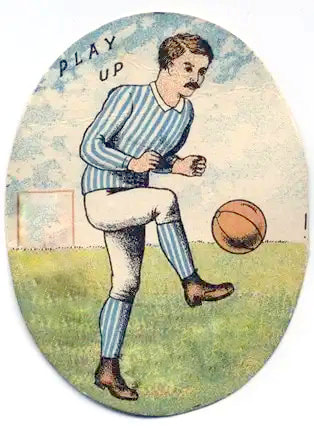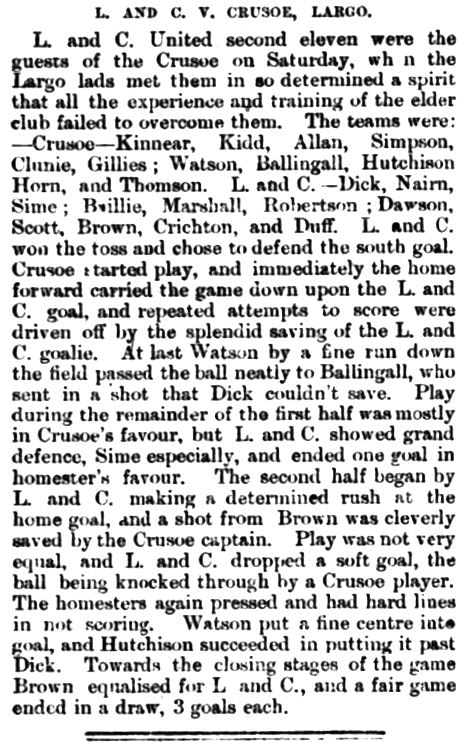Football had been played in Fife for some time before the game was formalised with the foundation of the Scottish Football Association (SFA) in 1873. Above is the description of a chaotic sounding match played in 1845 in Cupar, where twelve writers took on twelve tradesmen (Fife Herald 13 March). As the popularity of football accelerated among the general population, the Scottish Junior Football Association (SJFA) was formed (in 1886). The word 'junior' indicated the grade of football played rather than the age of the players. The term 'juvenile' was used for young players aged under 21 years.
The top tier Scottish Football League began in 1890 and over the years that followed football flourished at all levels, senior, junior and juvenile. Numerous teams were established, including many in Fife. An East Fife Football Association was set up in the early 1890s for junior clubs, with a 'juvenile' section added in 1895. Around the same year Largo had formed its own juvenile team, named Largo Crusoe. For many years, 'The Crusoe' flourished, competing in various cup competitions as well as local leagues. They played their home matches in Lundin Links, specifically at the ground which was then referred to as Homelands Park but is now known as The Common.
The match report above from 6 March 1896 East of Fife Record tells of a game against the L. and C. (Largoward and Colinsburgh). This report lists the Largo players' names and includes some familiar surnames such as Horne, Ballingall, Kidd, Clunie, Simpson and Gillies. Such names suggest much of the team were drawn from families with fishing connections - perhaps the reason for the team taking the Crusoe name (in a nod to their sea-faring heritage).
In 1897, the new season kicked off with the Largo men taking to the field in an opening match against Kilrenny F.C. - a team that called themselves the ”K.Y. team”. A good game was anticipated, as the opponents were chiefly employees of Cellardyke boot factory and hailed from Dundee. Nevertheless, the K.Y. "could not withstand the rushes of the Crusoe and retired defeated 7 goals to 4. The Crusoe were aided by Kennedy, Leven, who did some smart work centre-forward". Alexander Kidd the Largo Crusoe Club Secretary suggested that those interested in spectating "should lose no time in writing for dates". Above are the type of football shirts that players back then might have worn (from an 1897 catalogue).
In 1897 a short history of the first 11 years of the SJFA was published. This included professional photographs of 98 of 170 clubs with membership of the association. This included the St Andrews-based Ancient City Athletic - featuring John Ripley (2nd from left in the back row) who went on to be awarded the Victoria Cross in 1915 and is buried at Largo Cemetery. Also included was neighbouring team Leven Thistle. If you have or have ever seen a photograph of the Largo Crusoe Football Club from any stage in their existence, please get in touch. If you know what their team colours were, or have any other information about them, please comment.
Players Horne and Thomson (mentioned in the 1896 match report against the L. and C. above) must have been Largo Crusoe's star players. Both were chosen in 1898 for the East Fife Association select team to play against Edinburgh Association. The same year, both Andrew Horne and Thomas Thomson moved from juvenile to junior level to play for Leven Thistle (the year after the photo of the team above was taken). Horne in particular distinguished himself at Leven Thistle, which led to further moves - first to Buckhaven and then to Cowdenbeath to play at senior level in the Northern League.
Horne went on to sign for Dundee F.C. in May 1903, where he was described as their "best reservist" (see 19 November 1903 Leven Advertiser excerpt above). "Horne played himself into the good graces of the crowd" according to the Dundee Evening Post of 25 November 1903, which also remarked that "the Lower Largo lad is as game as they make them". However, an injury, sustained against Partick Thistle, impacted the later part of the season and Horne found himself on the move again. Rejecting a good offer from Middlesbrough, he elected to return to Cowdenbeath, in a move that would allow him to continue in the family joinery trade. The Fife fans were delighted to see the return of their "crack forward", pictured below, from the 1 October 1904 Dundee Evening Post.
Largo Crusoe Football Club, had their ups and downs during the years after Andrew Horne played for them. In 1910 they had "a respectable array of talent" according to local press and in 1911 the team made it to the final of the East Fife Cup. This closely contested match with Buckhaven Hawthorn (described below in the 14 June Leven Advertiser) ended in defeat, one goal to nil, for the Crusoe. The team considered contesting the result and requesting a rematch but this never came to pass.
Unsurprisingly, the Largo Crusoe team went into abeyance during the First World War. The local team re-emerged in the 1920s under the new name of Largo Rovers, who were later rebadged as Largo Thistle. The Second World War interrupted play once again, with Largo Villa being the team name thereafter. More on the exploits of those later teams another time.











 RSS Feed
RSS Feed
